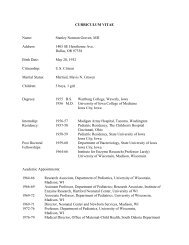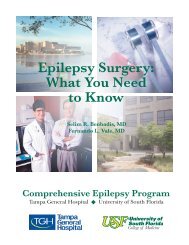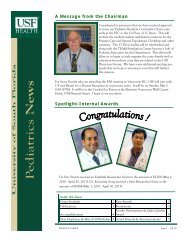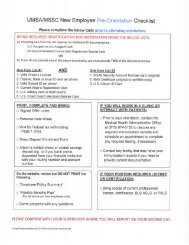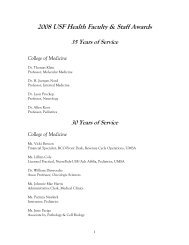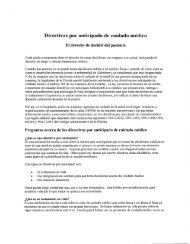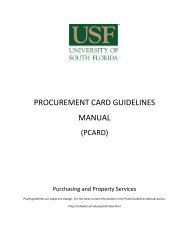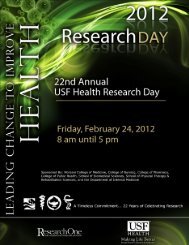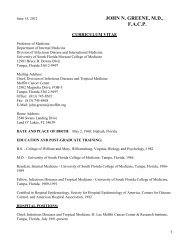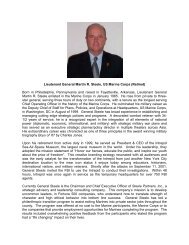Cognitive Testing: Achilles Heel of Clinical Neurology - USF Health
Cognitive Testing: Achilles Heel of Clinical Neurology - USF Health
Cognitive Testing: Achilles Heel of Clinical Neurology - USF Health
You also want an ePaper? Increase the reach of your titles
YUMPU automatically turns print PDFs into web optimized ePapers that Google loves.
<strong>Cognitive</strong> <strong>Testing</strong>. <strong>Achilles</strong> <strong>Heel</strong> <strong>of</strong><br />
<strong>Clinical</strong> <strong>Neurology</strong><br />
Michael H<strong>of</strong>fmann MD<br />
Stroke Program, <strong>Neurology</strong>, University <strong>of</strong> South Florida
Stroke and Cognition - a new era<br />
• Vascular cognitive disorder<br />
• Vascular cognitive impairment<br />
• Vascular dementia<br />
• Dementia: Vascular vs neurodegenerative<br />
• Alert, orientated x 3<br />
• MMSE<br />
• Neuropsychological testing<br />
• A treatable condition
Scope <strong>of</strong> the problem<br />
• Cerebrovascular disease and neuropsychiatric<br />
disorders are leading cause <strong>of</strong> disability worldwide<br />
• The frontal lobes comprise ~ 1/3 <strong>of</strong> the cerebrum<br />
and are supervisory to all other cortical and<br />
subcortical processes<br />
• The frontal lobes and their networks are damaged<br />
in over half <strong>of</strong> all ischemic stroke<br />
• No stroke measurement scale incorporates testing<br />
<strong>of</strong> frontal systems<br />
• This impacts decisions regarding treatment or<br />
management.
The importance <strong>of</strong> Metacognition<br />
Frontal network syndromes (FNS)<br />
• FNS are the most common cognitive disorders<br />
• Confirmed by animal models<br />
• FNS increasingly reported with discrete lesions<br />
outside anatomical boundary <strong>of</strong> the frontal lobe<br />
• Include; subcortical grey matter, subcortical<br />
white matter, isolated lesions <strong>of</strong> the brainstem,<br />
cerebellum, temporal and parietal lobes
Spectrum <strong>of</strong> Frontal Network<br />
Disorders<br />
• Structural (stroke, tumour)<br />
• Frontal Lobe Epilepsies<br />
• Schizophrenia<br />
• Anxiety<br />
• Depression<br />
• Obsessive Compulsive<br />
• Tourette’s syndrome<br />
• ADHD<br />
• Traumatic brain injury<br />
• Autism<br />
• Pervasive developmental<br />
disorders
<strong>Cognitive</strong> <strong>Testing</strong>.<br />
• Mental Status<br />
• Cranial Nerves<br />
• Motor System<br />
• Reflexes<br />
• Sensation<br />
• Coordination<br />
• Gait<br />
8/21/2006 6
Hemispheric dominance<br />
Left hemisphere<br />
Right hemisphere<br />
• Language<br />
• Analytical/mathematical<br />
• Temporal sequencing<br />
<strong>of</strong> stimuli<br />
• Attention<br />
• Prosody<br />
• Spatial construction<br />
• Body image<br />
• Melody<br />
• Emotion
QuickTime and a<br />
TIFF (LZW) decompressor<br />
are needed to see this picture.
<strong>Cognitive</strong> impairment and stroke.<br />
Pilot Data<br />
• H<strong>of</strong>fmann M, Sacco RS, Mohr JP, Tatemichi TK. Higher<br />
cortical function deficits among acute stroke patients: The<br />
Stroke Data Bank experience. Journal <strong>of</strong> Stroke and<br />
Cerebrovascular Diseases 1997;6:114-120<br />
• H<strong>of</strong>fmann M. Higher Cortical Functions After Stroke: An<br />
Analysis <strong>of</strong> 1000 Patients from a Dedicated <strong>Cognitive</strong> Stroke<br />
Registry. Neurorehabilitation and Neural Repair. 2001;15:113-<br />
127<br />
• H<strong>of</strong>fmann M, Schmitt. <strong>Cognitive</strong> impairment in isolated<br />
subtentorial stroke. Acta Neurologica Scandinavica<br />
2004;109:14-24.
QuickTime and a<br />
TIFF (LZW) decompressor<br />
are needed to see this picture.
Lhermitte F. Human Autonomy and The Frontal Lobes.<br />
Part 1: Imitation and Utilization Behavior. A Neuropsychological Study <strong>of</strong> 75 Patients.<br />
Ann Neurol1986;19:326-334.
Metacognition<br />
• Neural search<br />
engines<br />
• Frontal network<br />
syndromes<br />
ubiquitous<br />
• Analogy <strong>of</strong><br />
fever to<br />
infections
Coconut <strong>Testing</strong><br />
• Neuropsychological metric examination<br />
• Bedside behavioral neurological<br />
• Neuropsychiatric
Motor Programming<br />
Luria Hand Sequence Test
Neuropsychological Tests
Neuropsychological Tests<br />
• Wisconsin Card Sorting<br />
Test (4.0)<br />
• Frontal Systems<br />
Behavioral Test<br />
• Tower <strong>of</strong> London<br />
• Emotional Intelligence<br />
(Baron)<br />
• Comprehensive Trail<br />
Making Test
Emotional Intelligence<br />
Scoring
Frontal Systems Behavioral Scale<br />
• Lickert Scale<br />
• 46 questions<br />
• Executive dysfunction<br />
• Apathy<br />
• Disinhibition<br />
• Before/After options<br />
• T scores ≥65 impaired<br />
• T scores 6-64<br />
marginal
FRSBE<br />
QuickTime and a<br />
TIFF (Uncompressed) decompressor<br />
are needed to see this picture.
<strong>Cognitive</strong> stroke registry n=2000<br />
• Coma 154<br />
• Enceph 113<br />
• Frontal 340<br />
• Aphasia 283<br />
• Amnesia 268<br />
• Neglect Synd 88<br />
• Anosognosia 69<br />
• Apraxia 49<br />
• Visuospatial 41<br />
• Aprosodia 31<br />
• Alexia 23<br />
• Agnosia 16<br />
• Achromatopsia 8<br />
• Prosopagnosia 6<br />
• Angular Gy 7<br />
• Gerstmann’s 5<br />
• Pure Word 2<br />
• Alexia no agr 2<br />
• Anton’ Synd 2<br />
• Akinetopsia 2<br />
• Astereopsis 1<br />
• Foreign Acc 1<br />
• Del Mis ID 14<br />
• Normal 308
Misery Perfusion Syndrome. Post stent<br />
deployment<br />
QuickTime and a<br />
TIFF (LZW) decompressor<br />
are needed to see this picture.<br />
QuickTime and a<br />
TIFF (LZW) decompressor<br />
are needed to see this picture.
Young woman 36 y. NIHSS = 3, FNS score =<br />
16. Management: EC - IC bypass<br />
QuickTime and a<br />
TIFF (LZW) decompressor<br />
are needed to see this picture.<br />
QuickTime and a<br />
TIFF (LZW) decompressor<br />
are needed to see this picture.
A 24 year old man<br />
• NIHSS = 1<br />
• FNS = 32<br />
• Frontal syndrome with<br />
disinhibition,<br />
perseverative<br />
responses, stimulus<br />
bound behavior and<br />
echopraxia.<br />
• ICH<br />
QuickTime and a<br />
TIFF (LZW) decompressor<br />
are needed to see this picture.
Dysexecutive syndrome<br />
• Subcortical lesions<br />
• Frontal subcortical<br />
circuits<br />
Kramer et al. Executive<br />
dysfunction in subcortical<br />
ischemic vascular disease. J<br />
Neurol Neurosurg Psych<br />
2002;72:217-220
Abulia - spectrum <strong>of</strong> disorders<br />
• Athyhmhormia<br />
• Abulia<br />
• Apathy<br />
• Akinetic mutism<br />
QuickTime and a<br />
TIFF (LZW) decompressor<br />
are needed to see this picture.
32 year old woman<br />
• Post partum<br />
• Pr<strong>of</strong>ound abulia<br />
• Severe frontal<br />
syndrome<br />
QuickTime and a<br />
TIFF (LZW) decompressor<br />
are needed to see this picture.<br />
• Duration 5 days
Deep venous thrombosis<br />
QuickTime and a<br />
TIFF (LZW) decompressor<br />
are needed to see this picture.<br />
QuickTime and a<br />
TIFF (LZW) decompressor<br />
are needed to see this picture.
Accurate diagnosis and treatment<br />
• Both the syndrome<br />
(simultanagnosia)<br />
and…..<br />
• mechanism<br />
(eclampsia) required<br />
for firm diagnoses<br />
• Call Fleming<br />
syndrome not<br />
unexpected<br />
QuickTime and a<br />
TIFF (Uncompressed) decompressor<br />
are needed to see this picture.
Posterior lesions and frontal<br />
syndromes<br />
QuickTime and a<br />
TIFF (Uncompressed) decompressor<br />
are needed to see this picture.
Mandarin Chinese – an example <strong>of</strong><br />
a tone language<br />
• Mandarin phoneme tone English word<br />
• Ma mother<br />
• Ma numbness<br />
• Ma horse<br />
• Ma curse
Transcortical Motor Aphasia<br />
• Internal watershed<br />
infarction<br />
• Misdiagnosed as<br />
multiple sclerosis
Denying blindness<br />
• Cerebroappendicular<br />
syndrome<br />
• Top <strong>of</strong> basilar<br />
syndrome<br />
• Cortical blindness<br />
• Anton’s syndrome<br />
• Visual agnosia
FNS by stroke severity. F ratio 4.7, r=0.2, p=0.03<br />
50<br />
40<br />
FNS<br />
30<br />
20<br />
10<br />
-2 0 2 4 6 8 10 12 14<br />
NIHSS
Lesion location vs FNS: ANOVA<br />
50<br />
40<br />
FNS<br />
30<br />
20<br />
10<br />
0<br />
Frontal Multiple SC grey Subtentorial SC white TOP Normal<br />
Location<br />
All Pairs<br />
Tukey-Kramer<br />
0.05
Organicity: Structural/Chemical/Electrical<br />
• Decrease in<br />
metabolism in<br />
depression<br />
relative to<br />
controls.<br />
• Drevets et al.<br />
Nature<br />
1997;386:824-827
Principle chemical projections to<br />
cerebral cortex<br />
State dependent systems<br />
1. Cholinergic - n. basalis <strong>of</strong> Meynert<br />
2. Histaminergic - hypothalamus<br />
3. Dopaminergic - ventral tegmental area<br />
4. Serotonergic - brainstem raphe nuclei<br />
5. Noradrenergic - locus ceruleus
Pharmacotherapy <strong>of</strong> cognitive disorders<br />
• Aricept in aphasia<br />
• Dopamine effective for<br />
working memory *<br />
• Dopamine for akinetic<br />
mutism<br />
• Dopamine in apathy<br />
• Modafanil in apathy<br />
• Bromocriptine in motor<br />
aphasia<br />
*<br />
Knecht S, Breitenstein C, Bushuven S, Ringelstein EB. Levodopa:<br />
Faster and better word learning in normal humans. Ann Neurol 2004;56:20-26
Experimental trial<br />
• Primary aims: To test the hypothesis<br />
that metacognitive deficits in young<br />
people with stroke are improved with<br />
dopaminergic medication by comparing<br />
pre and post treatment test scores<br />
following a 6 week randomized, double<br />
blinded placebo controlled trial using<br />
dopaminergic therapy.
Experimental Trial<br />
• Secondary Aim: To test the hypothesis<br />
that different metacognitive components<br />
(attention, executive function, emotional<br />
intelligence, apathy, disinhibition) and<br />
their subtest scores are differentially<br />
affected by dopaminergic therapy.
Why the fuss ?<br />
• <strong>Health</strong> policy planners long needed an index <strong>of</strong><br />
frontal dysfunction to determine eligibility for<br />
long-term care benefits.<br />
• Improved imaging capability <strong>of</strong> MRI, SPECT<br />
and PET scanners delineated frontal impairment<br />
without gross frontal lesions.<br />
• Strong link between impaired frontal function by<br />
testing and impaired performance in the goal<br />
directed behavior:careers and employment
State dependent vs “hard wired”<br />
network systems<br />
• Diagnosis <strong>of</strong> frontal systems impairment in<br />
patients, not imageable by surrogate markers<br />
such as MRI or PET scans ?<br />
• Schizophrenia, depression and frontal<br />
subcortical systems impairment attest to the<br />
severity <strong>of</strong> frontal dysfunction with normal<br />
neuroimaging.<br />
• Improved clinical diagnostics will remain the<br />
directional beacon to follow
Quantitative Frontal Bedside <strong>Testing</strong><br />
• Ettlin TM, Kischka U, Beckson M, Gaggiotti M, Rauchfleisch U,<br />
Benson DF.The Frontal Lobe Score: part I: construction <strong>of</strong> a<br />
mental status <strong>of</strong> frontal systems. Clin Rehabil. 2000<br />
Jun;14(3):260-71<br />
• Dubois B, Slachevsky A, Litvan I, Pillon B. The FAB. A frontal<br />
assessment battery at the beside. <strong>Neurology</strong> 2000;55:1621-1626<br />
• Royall DR, Mahurin RK, Gray KF. Bedside assessment <strong>of</strong><br />
executive cognitive impairment: the executive interview. J Am<br />
Geriatr Soc 1992;40:1221-1226<br />
• H<strong>of</strong>fmann M, Schmitt F. Metacognition in stroke. Bedside<br />
assessment and relation to location, size and stroke severity.<br />
<strong>Cognitive</strong> and Behavioral <strong>Neurology</strong> 2006;19(2):85-94.
Thank You
Affecting tone and color <strong>of</strong> behavior as opposed to<br />
content<br />
• NA - Novelty seeking behavior and<br />
resistance to distraction<br />
• DA - Encoding <strong>of</strong> reward and effort<br />
associated with cognition<br />
• 5HT - sensory gating <strong>of</strong><br />
environmentally behavioral clues<br />
• Ach - promotes arousal,<br />
motivational valence, learning<br />
• Hist - cortical arousal, energy<br />
metabolism, autonomic function<br />
<strong>Cognitive</strong> Impairment in Isolated Subtentorial<br />
Stroke. H<strong>of</strong>fmann M 1, Schmitt F 2.<br />
Department <strong>of</strong> <strong>Neurology</strong>, University <strong>of</strong><br />
South Florida, Tampa Fl 1 and<br />
Department <strong>of</strong> <strong>Neurology</strong> University <strong>of</strong><br />
Kentucky, Lexington KY 2. Acta<br />
Neuologica Scandinavica 2004;109:14-<br />
24<br />
Adapted from Silber M. <strong>Neurology</strong> 2001



